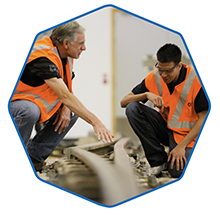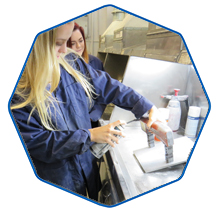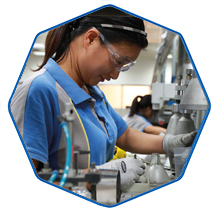Unconscious Bias
Unconscious bias – What is it?
Unconscious biases are simply our unintentional people preferences. Social psychologists and neuroscientists tell us that our unconscious mind automatically, rapidly, intuitively and effortlessly categorises people (it pigeonholes). This enables us to make rapid decisions about people without having to engage the limited resources of the conscious mind that are required for the more complex cognitive tasks such as problem solving and planning. Unconscious biases operate in less than a tenth of a second, many times faster than our eyes can even process an image. In the past, these super-fast neural connections enabled us to make rapid threat assessments and were a vital safety method. In a modern and increasingly complex business world they enable us to make cognitive shortcuts, but often they lead us to make intuitive but error-prone decisions about people. The most prevalent effect of unconscious bias is affinity bias.
 Impacts of unconscious bias
Impacts of unconscious bias
Unconscious bias tends to interfere with the way in which we:
Listen
We tend to listen to and value the opinions of people more like us or who are in dominant groups and we remember contributions differently too.
Employ
In sifting job applications and in interviews we tend to select people to work with us and for us who are similar to us.
Work with and allocate work
We tend to prefer team members who are more like us and to allocate them the more interesting, challenging and developmental work or projects.
Feedback
We are more comfortable giving feedback to people who are similar to us.
Informally mentor, coach and sponsor
We tend to advise and speak up more for people like us.
 Types of unconscious bias
Types of unconscious bias
Affinity bias
We have an inclination to prefer people who are similar to us on the basis of a wide range of characteristics, including social or career background, gender, accent, education, ethnicity, age, hobbies and interests, etc.
Attribution bias
We have an inclination to explain behaviour differently for different groups of people. We tend to explain the successes of people more like us as being down to them and explain away their failures as being due to some external factors (for example, being unlucky or let down by others). However, we tend to explain the successes of people less like us as being caused externally (for example, being lucky or the actions of others) and to blame them for their failures.
Confirmation bias
We see and hear what we expect to see and hear. Once we feel someone or a situation is a particular way, we seek out information to confirm it and ignore evidence to the contrary.
Comparison bias
When we compare things, we tend to exaggerate the differences.
 Source bias
Source bias
Sometimes the source of the information becomes more important than the information itself and we tend not to challenge or test out those sources in as rigorous a way.
Benevolent bias
This is often seen as a desire to look after to protect, by not exposing a person to challenge (for example, a difficult customer or other conditions of work).
Halo/horns bias
When someone has a characteristic that we strongly like or dislike, it can colour our whole assessment. We extend that liking or disliking into other areas of our assessment of them.
Primacy, recency and impact bias
The first incidence of something, the recent incidents and the incidents that have a major impact (for example, a major success or embarrassment) tend to be easier to recall.
Status quo bias
The desire to avoid change or not ‘rock the boat’.
Bias blind spot
We struggle to see the defects in our own decision making; often others can see it, but we cannot.
Stereotyping
The use of stereotypes about social groups to make judgements about individuals within the groups.
 Top research-led tips to mitigate unconscious bias:
Top research-led tips to mitigate unconscious bias:
Get tested:
Insight into our biases can help us choose the times when we employ mitigation techniques.
Have contact:
Positive contact with people from groups for whom we may have a bias makes it more difficult for the brain to pigeonhole people.
Use role models:
Remembering people who have impressed us or made a real contribution helps us mitigate bias. Recalling those people when we have a decision to make mitigates bias.
Counter stereotypes:
Simply trying to suppress a stereotype about a group makes it more likely you will use it. Reminding yourself of statements that oppose the stereotype (for example, positive attributes of a group or person) mitigates bias.
 Perspective taking:
Perspective taking:
Putting yourself in someone else’s position or trying to see things from their point of view.
Avoid reinforcement:
Avoiding pejorative jokes, removing media that promotes negative stereotypes and recognising when your biases may be getting reinforced all help.
Avoid triggers:
We do not make sound people decisions when we are stressed, hungry, tired or anxious because our brain’s bias control resources are shared with our emotional regulation and cognitive processing.
Slow down:
Slowing down key decisions with a short gap often enables our impulsive decisions to become more considered.
Challenge:
We can impact the biases of our wider group by politely challenging biases that we hear at play, initially through a reminder of the facts.
 For more information about unconscious bias, click on the following links:
For more information about unconscious bias, click on the following links:
Employers Network for Equality and Inclusion (ENEI.org)
‘What is unconscious bias’
https://www.enei.org.uk/diversity-inclusion/unconscious-bias/
Royal Society
‘Understanding unconscious bias
https://royalsociety.org/topics-policy/publications/2015/unconscious-bias/
You-tube - Trainer Bubble
Unconscious bias and the danger of pre-judged thought
https://youtu.be/d8dvbWrjuto
For further information contact: Diversity and Inclusion Advisory Group, The British Institute of Non-Destructive Testing,
Midsummer House, Riverside Way, Bedford Road, Northampton NN1 5NX, UK.
Tel: +44 (0)1604 438300; Fax: +44 (0)1604 438301; Email: diversity@bindt.org; Web: www.bindt.org
 Impacts of unconscious bias
Impacts of unconscious bias Unconscious bias tends to interfere with the way in which we:
Listen
We tend to listen to and value the opinions of people more like us or who are in dominant groups and we remember contributions differently too.
Employ
In sifting job applications and in interviews we tend to select people to work with us and for us who are similar to us.
Work with and allocate work
We tend to prefer team members who are more like us and to allocate them the more interesting, challenging and developmental work or projects.
Feedback
We are more comfortable giving feedback to people who are similar to us.
Informally mentor, coach and sponsor
We tend to advise and speak up more for people like us.
 Types of unconscious bias
Types of unconscious bias Affinity bias
We have an inclination to prefer people who are similar to us on the basis of a wide range of characteristics, including social or career background, gender, accent, education, ethnicity, age, hobbies and interests, etc.
Attribution bias
We have an inclination to explain behaviour differently for different groups of people. We tend to explain the successes of people more like us as being down to them and explain away their failures as being due to some external factors (for example, being unlucky or let down by others). However, we tend to explain the successes of people less like us as being caused externally (for example, being lucky or the actions of others) and to blame them for their failures.
Confirmation bias
We see and hear what we expect to see and hear. Once we feel someone or a situation is a particular way, we seek out information to confirm it and ignore evidence to the contrary.
Comparison bias
When we compare things, we tend to exaggerate the differences.
 Source bias
Source biasSometimes the source of the information becomes more important than the information itself and we tend not to challenge or test out those sources in as rigorous a way.
Benevolent bias
This is often seen as a desire to look after to protect, by not exposing a person to challenge (for example, a difficult customer or other conditions of work).
Halo/horns bias
When someone has a characteristic that we strongly like or dislike, it can colour our whole assessment. We extend that liking or disliking into other areas of our assessment of them.
Primacy, recency and impact bias
The first incidence of something, the recent incidents and the incidents that have a major impact (for example, a major success or embarrassment) tend to be easier to recall.
Status quo bias
The desire to avoid change or not ‘rock the boat’.
Bias blind spot
We struggle to see the defects in our own decision making; often others can see it, but we cannot.
Stereotyping
The use of stereotypes about social groups to make judgements about individuals within the groups.
 Top research-led tips to mitigate unconscious bias:
Top research-led tips to mitigate unconscious bias:Get tested:
Insight into our biases can help us choose the times when we employ mitigation techniques.
Have contact:
Positive contact with people from groups for whom we may have a bias makes it more difficult for the brain to pigeonhole people.
Use role models:
Remembering people who have impressed us or made a real contribution helps us mitigate bias. Recalling those people when we have a decision to make mitigates bias.
Counter stereotypes:
Simply trying to suppress a stereotype about a group makes it more likely you will use it. Reminding yourself of statements that oppose the stereotype (for example, positive attributes of a group or person) mitigates bias.
 Perspective taking:
Perspective taking:Putting yourself in someone else’s position or trying to see things from their point of view.
Avoid reinforcement:
Avoiding pejorative jokes, removing media that promotes negative stereotypes and recognising when your biases may be getting reinforced all help.
Avoid triggers:
We do not make sound people decisions when we are stressed, hungry, tired or anxious because our brain’s bias control resources are shared with our emotional regulation and cognitive processing.
Slow down:
Slowing down key decisions with a short gap often enables our impulsive decisions to become more considered.
Challenge:
We can impact the biases of our wider group by politely challenging biases that we hear at play, initially through a reminder of the facts.
 For more information about unconscious bias, click on the following links:
For more information about unconscious bias, click on the following links:Employers Network for Equality and Inclusion (ENEI.org)
‘What is unconscious bias’
https://www.enei.org.uk/diversity-inclusion/unconscious-bias/
Royal Society
‘Understanding unconscious bias
https://royalsociety.org/topics-policy/publications/2015/unconscious-bias/
You-tube - Trainer Bubble
Unconscious bias and the danger of pre-judged thought
https://youtu.be/d8dvbWrjuto
For further information contact: Diversity and Inclusion Advisory Group, The British Institute of Non-Destructive Testing,
Midsummer House, Riverside Way, Bedford Road, Northampton NN1 5NX, UK.
Tel: +44 (0)1604 438300; Fax: +44 (0)1604 438301; Email: diversity@bindt.org; Web: www.bindt.org